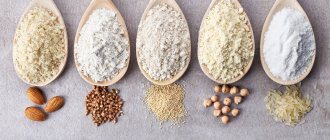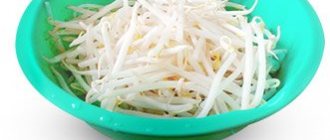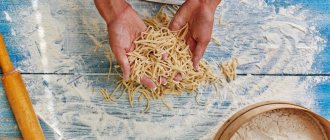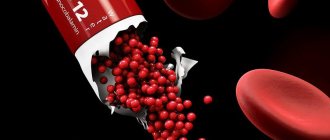Product table
According to this table, each type of blood group has its own foods. Moreover, some of them lead to weight loss, others to weight gain.
Before you go on a diet, you need to understand that there are recommended, prohibited and neutral foods. The former are very good for the body, the latter, on the contrary, are contraindicated, as they will lead to unwanted weight gain. As for neutrals, they are included in the diet, but in small quantities.
Based on this, the most complete and detailed table of foods suitable and prohibited for different blood groups will look like this:
Recommended Products

Limited Products

Foods that increase weight

Weight Loss Products
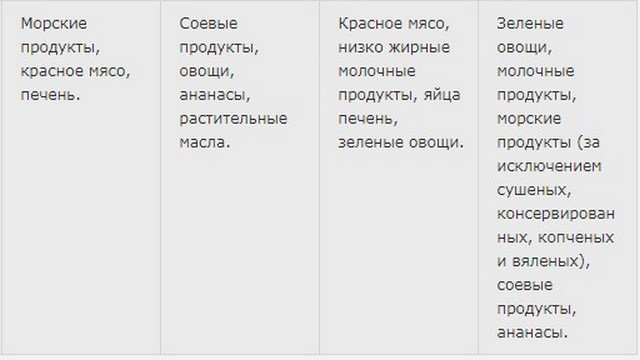
Each blood group has its own set of products and, accordingly, its own menu. Below we will look at the most typical menu sets for each group. These are just recommendations. Based on the tables of permitted and prohibited foods, you can create your own menu.
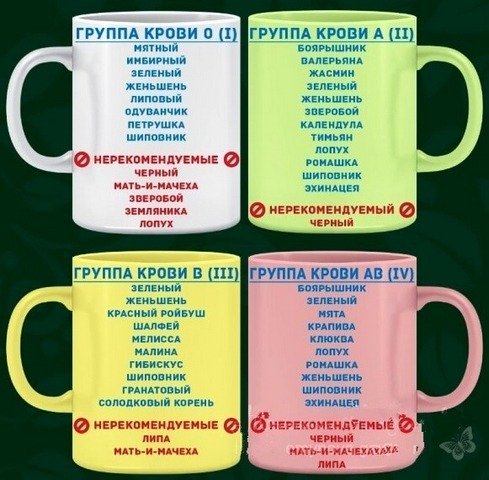
Particularly about the diet for people with blood group I
In 90% of cases, the indigenous Russian people are carriers of the 1st blood group (Europeans mostly have the 2nd, and Asians have the 3rd blood group). Let's take a closer look at how we can eat to be healthier (I also have blood of this type).
According to the conclusions of Peter D'Adamo, one should abstain from potatoes (as well as people with blood types 2 and 3), wheat bread and all baked goods made from wheat flour, pasta, pork, salted herring, pickles and marinades, from all dairy and fermented milk products, white and cauliflower cabbage, from vodka - but these are all products that are native to us, both today and our ancestors.
Well, with vodka it’s clear: alcohol abuse puts a strain on the liver (it decomposes alcohol into acetaldehyde, a strong toxin that causes a severe hangover) and alcohol negatively affects brain cells and nerve cells.
How can you live without cereals, bread, cabbage, dairy products and pasta? Such a depleted (unbalanced) diet upset me.

But having suppressed my emotions about the ban on familiar foods, I thought: if the D'Adamo diet helps to improve the health of the body, and each blood type has its own diseases, then what diseases for people with blood type 1 is the D'Adamo diet aimed at suppressing?
According to statistics, the most common diseases for them are diseases of the gastrointestinal tract, as well as diseases of the heart and blood vessels, thyroid gland, inflammatory processes and other ailments.
Now, if we compare the therapeutic diet for diseases of the digestive tract - gastritis, ulcers, colitis and others (table No. 1 in sanatoriums and medical institutions) with the diet proposed by D'Adamo, it turns out that they are practically the same.
So, for both diets, bread, legumes, pasta, cereals, white cabbage, dairy products, salted, pickled and pickled vegetables, and fatty meats are prohibited.
The ban on these products is explained by the fact that the digestive tract of people with blood group 1 is not suitable for normal digestion of dairy products and potatoes, and wheat, cereals and legumes contain the harmful lectin “gluten” (it glues red blood cells together).
The listed products slow down the metabolism, but doctors reassure that the metabolic rate can be increased by taking B vitamins. These vitamins are involved in all metabolic processes and are found in plant foods.

Doctors also advise taking brown algae - fucus vesicularis, an alkaline product that contains iodine and helps protect the stomach from ulcers caused by the bacterium Helicobacter pylori.
Alkaline fucus neutralizes hydrochloric acid, which is actively secreted by the stomach to digest meat (protein). In addition, this algae is an oncoprotector. It can be purchased dried and ground and used as salt.
In addition, as scientists found out much later, harmful lectins contained in wheat and other grains, beans and tomatoes in small quantities are beneficial (they work against cancer), moreover, when grains and beans are soaked and then heat-treated, the lectins are destroyed ( read interesting about lectins ).
Among the neutral foods for people with blood type 1 in the D'Adamo diet are buckwheat, rice, carrots, beets, cucumbers, tomatoes, peas, lettuce, eggs, chicken, homemade cottage cheese and cottage cheese, white and red wine.
Well, let's listen to D'Adamo's conclusions, taking into account modern research.
Menu for 1 blood group
Blood type 1 is one of the most common, accounting for more than 33% of the world's population. This group is considered the most ancient and ancestral. Hunting is where human life began. People in this group have a good digestive system. For them, a meat diet, as well as various seafood, is best suited. In order not to gain weight, it is necessary to exclude foods such as wheat, corn, cabbage, and oats from the menu. In addition, it is not recommended to use aspirin as a medicine, as well as vitamin complexes that contain retinol and tocopherol.
A sample menu for three days for people of this blood type will look like this:
1 day
For breakfast, you can make a sandwich of rye bread with butter and cheese. The best drink to drink is herbal tea.
Lunch consists of salad, chicken soup with sorrel and broccoli. The salad can be made from chicken or beef liver, tomato and spinach. It is better to season it with soy sauce.
Scientific evidence for the blood diet
The study found that adults who made food choices based on their blood type experienced improved health outcomes. But similar changes occurred in the control group, which was guided by the principles of proper nutrition. In 2013, a review of several studies found that the benefits of eating well based on blood type were not proven . Most likely, people who chose foods based on genetic characteristics lost weight because they excluded fatty, fried and sugar from their diet.
Menu for blood group 2
Group 2 left the first. When the hunters decided to settle down and start growing plants. About 38% of people belong to this blood group. Their diet is based exclusively on plant foods. This is due to the fact that people with the second group have low acidity, and therefore it is more difficult to digest meat foods.
The menu for the second group looks like this:
1 day
Rice porridge with apricots is prepared for breakfast. As a drink - green tea.
For lunch - vegetable cream soup, vegetable salad. The salad can be prepared from any vegetables, but the soup includes carrots, Brussels sprouts, potatoes, and pine nuts. A salad made from tomatoes, cucumbers and radishes will be very tasty and healthy. Salad dressing – olive oil.
For dinner - stewed champignons with carrots and zucchini, pineapple juice. Between lunch and dinner, you can snack on cashews or Brazil nuts. In addition, you need to eat one thing: a tomato or a cucumber.
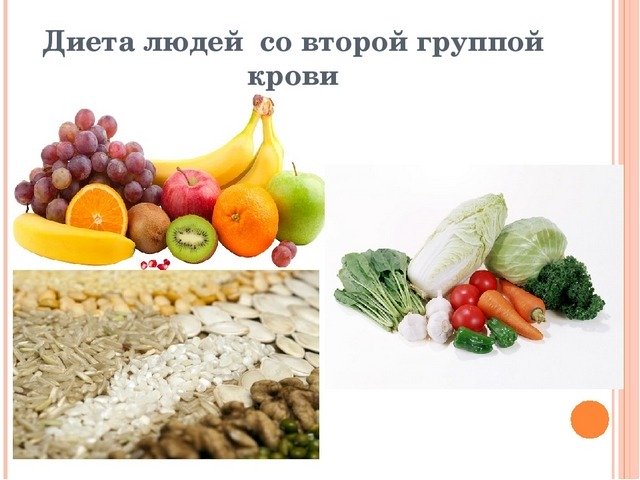
Day 2
For breakfast, prepare buckwheat porridge with soy milk and green tea.
For lunch - a salad of carrots, asparagus and greens. Soup - sorrel with eggs. We wash it all down with cherry juice.
Dinner – turkey fillet, side dish with rice and vegetables, cranberry juice. Between lunch and dinner, you can snack on pine nuts, walnuts, and almonds. For fruits, eat apricots or plums, prunes or dried apricots.
Day 3
For breakfast, a vegetable salad and coffee are prepared.
For lunch - mushroom soup with vegetables, as well as a salad of cheese, cucumbers, eggs and apples.
Dinner consists of baked fish and beans. And between lunch and dinner we snack on nuts and fruits.
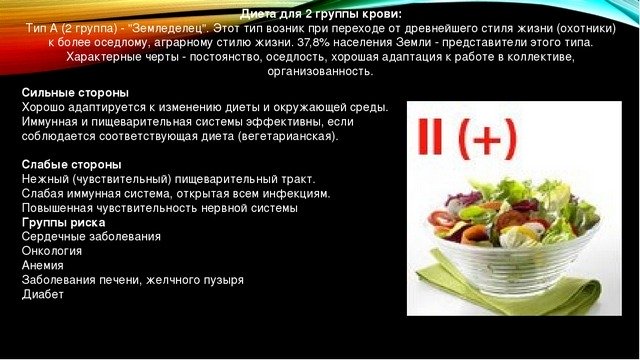
What should the third group, the “nomads”, take into account?
There are about 20% of people on the planet with the third blood group. This group appeared during the times of mass migration of peoples. At that time, they had to eat whatever they could find or catch. Therefore, D'Adamo believes that representatives of the 3rd group best absorb a variety of foods, and their diet should be as wide as possible.
Useful products for such people are:
| Product group | Scroll |
| Meat products |
|
| Fish |
|
| Dairy |
|
| Bakery products |
|
| Cereals |
|
| Legumes |
|
| Berries and fruits |
|
| Vegetables |
|
| Oils |
|
| Beverages |
|
It is not recommended to use:
- pork;
- chicken;
- lentils;
- corn;
- olives;
- Rye bread;
- seafood;
- peanut;
- alcohol;
- sweets: ice cream, candies, cookies, etc.;
- some vegetables and fruits: tomatoes, persimmons, avocados, rhubarb, coconut, pomegranate;
- carbonated drinks.
People with this blood type are less likely to be overweight. Therefore, according to the naturopath, diet for them will only be a way to normalize metabolism.
Nuances when preparing a diet
Representatives of the third blood group have the following characteristics:
- High adaptation to external conditions.
- Persistent nervous system.
- Strong immunity.
- Good sensitivity to new foods.
People with blood type 3 are classified by naturopaths as omnivores, as they can eat a variety of foods without affecting their health and weight.
It is also recommended for this category of the population to observe moderation during physical activity.
Tips for creating a menu:
- There are fatty varieties of fish to reduce inflammatory processes.
- Eat meat 2-3 times a week.
- Introduce dairy products into your diet.
- Add spices to food: parsley, ginger, mint. They stimulate the production of enzymes and improve digestion.
Sample menu for the day:
| Time | Dishes |
| Breakfast |
|
| Lunch | Dried apricots and raisins |
| Dinner |
|
| Afternoon snack |
|
| Dinner |
|
Menu for 4 blood groups
This is the youngest blood group, the carriers of which are no more than 8% of the planet's inhabitants. This group arose as a result of the mixing of three others. As a result, the diet is based on the principle of combination and is moderate. At the same time, the menu has not been clearly worked out, and therefore you can experiment here. For example, we use meat, but in small quantities and only with vegetables.
The menu for the fourth group is as follows:
Day 1
For breakfast we prepare oatmeal with apricots and apples.
For lunch we make a salad of eggs, cheese and sardines, seasoned with sour cream or olive oil. The main course is vegetable cream soup.
Dinner consists of boiled lamb with peppers and eggplants. As for a snack between lunch and dinner, you will need nuts, carrots (you can have a cucumber), and any fruit.

Day 2
For breakfast we just make rice porridge. Lunch consists of fruit salad, cream soup from different types of cabbage.
For dinner you can cook seafood julienne. Snack, as usual, nuts, dried apricots, prunes. You can add rye bread to them.
Day 3
For breakfast, yogurt and pear will be enough. The drink is sea buckthorn juice.
For lunch we make a salad of Chinese cabbage, tomato, turkey, cheese and vegetable soup.
Dinner will consist of baked fish with a side dish of rice. As for a snack or afternoon snack, nuts, fruits and kefir are suitable.

Nutrition for groups I and II
We owe the development of this scheme to naturopathic doctor Peter D'Adamo, originally from America. In his opinion, a person’s genetic characteristics, in particular his blood type, influence the absorption of certain foods and nutritional components.
In this vein, particular importance is attached to the absorption of lecithins, which serve as an important building material for cells. They are found in almost all types of products, but the chemical characteristics of “animal” and “vegetable” lecithins are fundamentally different. The diet proposed by D'Adamo allows you to saturate the body with exactly those lecithins that will be absorbed best, promoting cell renewal and growth.
According to the D'Adamo system, products for each group are divided into three categories:
- healthy – perfectly digestible and suitable for daily use;
- neutral – they have no benefit, but can occasionally be included in the diet;
- harmful - they are poorly digested, adversely affect well-being and provoke excess weight gain.
Avoiding foods that are not suitable for a particular group will promote optimal functioning of all organs and systems. A person will be able to normalize their weight, get rid of fat deposits, cleanse themselves of toxins, improve their well-being and increase their performance.
Peter D'Adamo argues that all carriers of a certain blood type are united by a common past. The diet of these individuals centuries and even millennia ago was determined by the type of activity - thus, ingredients of plant or animal origin predominated in the food.
The naturopathic doctor does not limit the adherents of his nutritional system in the size of portions and does not force them to eat strictly according to the clock. A person must reconsider his eating habits and rearrange his eating schedule so that he does not feel hungry during the breaks between meals. Eating according to D'Adamo does not guarantee rapid weight loss, so to achieve a noticeable result you will have to add physical activity.
There is an unconfirmed but very widespread belief that in ancient times everyone had only one blood type - the first. Primitive people were hunters and ate mainly meat. The overwhelming majority of them were armed warriors and did not have the opportunity or skills to, for example, engage in agriculture or raise livestock.
In the modern world, approximately a third of the world's population has the first blood group. If you follow the concept of nutrition of “hunters”, then for people with the first (I or 0 according to the international classification) blood group the following products are preferred: meat (red), sea fish and seafood , organ meats, lettuce, broccoli, olive oil and nuts.
What is not recommended to eat: foods containing gluten, dairy products, legumes, cabbage and apples. This food can make you feel worse and will not help you lose weight at all. Taking into account the meat diet, people in the first group are recommended to combine diet with exercise.
Representatives of the second (A or II) blood group were already “farmers”. They ate mainly plant foods, so for modern owners of the second (A or II) group, vegetarianism is preferable. The approximate number of carriers is 38% of the world's population.
The “farmer’s” diet should consist of cereals, fruits, cereals and oils. Meat must be removed completely or its consumption reduced to a minimum. Fish and seafood should not be completely excluded.
It is undesirable to consume beans, wheat flour containing gluten, dairy products, sweet soda and orange juice. If you have blood type 2 (positive or negative – it doesn’t matter so much), you should also not consume meat and milk. This is a necessary measure to eliminate the risk of cancer and heart disease.
Representatives of the third group are the “nomads”. Immigration of peoples settling throughout the planet led to new eating habits and greater endurance of the body. Holders of the third (B or III) blood group are the owners of the most balanced diet, rich in any vitamins and microelements.
We invite you to read Diet on cucumbers and tomatoes alone
Their diet should include: meat, fish, fruits, vegetables, dairy and fermented milk products. Only seafood, legumes, nuts and alcoholic beverages can harm the “nomads”. Most often, representatives of this group follow a diet not for the sake of losing weight, but to strengthen the immune system. Although this type of people has extreme endurance, they are often susceptible to autoimmune diseases and suffer from chronic fatigue syndrome. In addition, rare viruses are very dangerous for “nomads”.
People with the fourth blood group are a separate category. This group is still the youngest and most unexplored. It arose from the mixing of groups 2 and 3, and so far only 7% of the world's population are carriers.
Products for blood group AB (IV) are very original, both recommended and contraindicated. Thus, the following are allowed: fish, caviar, soybeans, dry red wine, rice (including rice wafers or flour), dairy and fermented milk products, green vegetables and fruits. Do not overuse meat, seafood, mushrooms, nuts, legumes, citrus fruits and bananas.

People with blood group 4 most often have a weak digestive system, and there is also a tendency to oncology and nervous disorders. At the same time, this is the most adaptable group; it will not be difficult for them to get used to new living and eating conditions. To maintain the strength of the body, owners of the fourth (AB or IV) blood group need to eat well according to a diet written specifically for this type of people; In addition, you need to supplement your diet with various vitamin and mineral complexes.
The diet for each of the owners of the four common blood compositions is calculated taking into account the needs of representatives of these groups. The table of products whose consumption is recommended or prohibited is freely available, and anyone can study it in detail.
Power supply for the first group O(I)
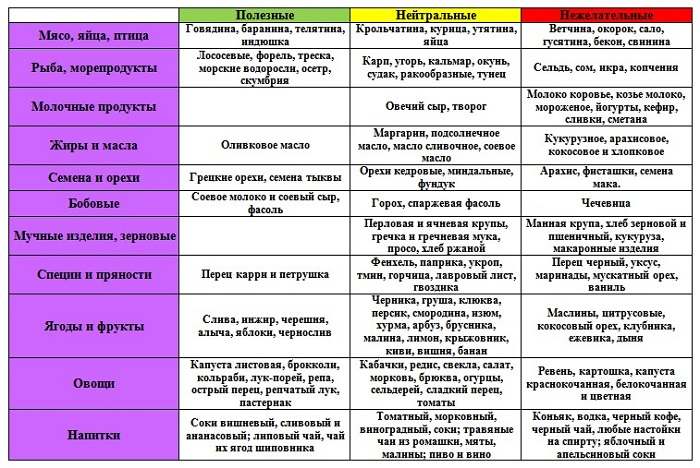
Nutrition table for blood group 1
Nutrition for the second blood group A(II)

Nutrition table for blood group 2
Nutrition for the third blood group B(III)
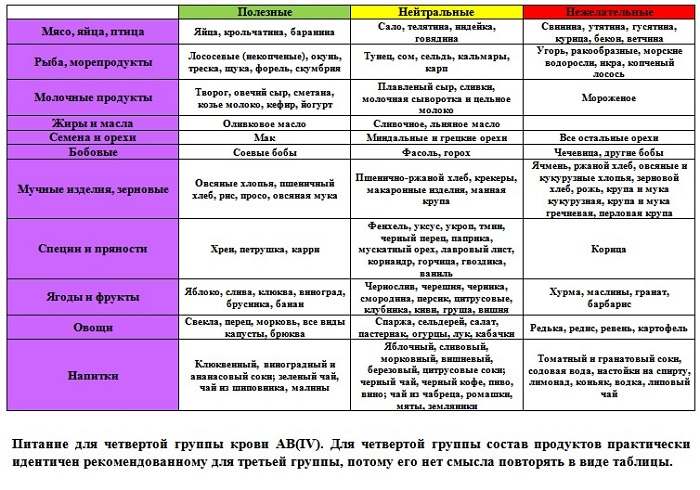
Nutrition table for the third blood group
What are the advantages and disadvantages of the diet?
Unlike other diets, this one is quite controversial. She has many supporters and those who consider her wrong.
One of the disadvantages is this. That this diet does not take into account age, gender, or various diseases.
Here's an example. For blood group O, it is not recommended to drink coffee. But if a person has hypotension and cannot live without coffee. For hypertensive patients, salt and fish are harmful. For those with high cholesterol, meat and eggs can be harmful.
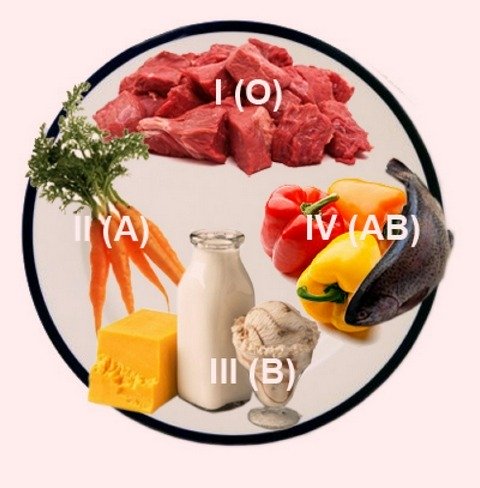
The advantage is that by including diet-allowed foods in your diet, you can improve your health. Moreover, Rh does not matter here at all, so the menu for people with positive Rh is exactly the same as for people with negative Rh.
However, it is still better to consult a doctor before going on a diet. As for doctors, watch this interesting video from a program about health broadcast on the Russia 1 channel.
Diet according to blood type and its features
This is interesting: 6 petals diet: menu for every day, week, features, results, photos + REVIEWS
This nutritional scheme appeared as a result of the work of two generations of nutritionists from America named D'Adamo on it. If their claims are to be believed, our bodies have evolved to require different foods due to differences in blood type. Traditional science and nutrition reject this idea, but it has a huge number of followers who have achieved considerable success.
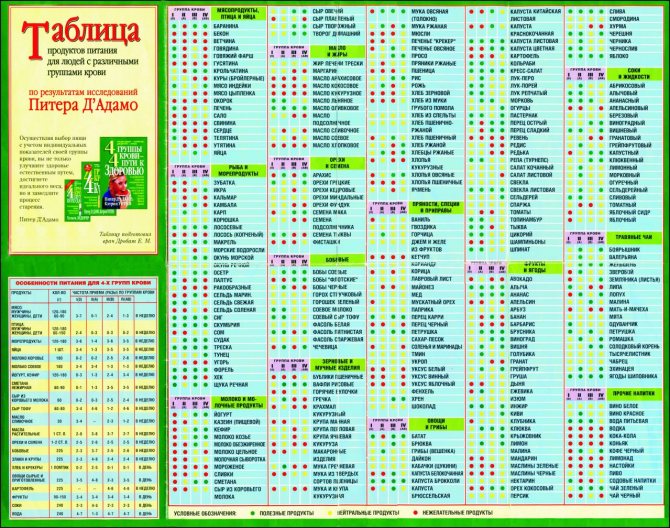
Nutrition table
Naturopathic doctor Peter D'Adamo from the United States of America claims that all people differ from each other not in the color of their skin, hair, eyes and other external features, but in their blood type. This is the main difference. He bases this statement on the research of his father, James D'Adamo , and his many years of practice.
The thing is that each of the four blood groups interacts differently with lecithins, which are involved in the structure of the human cell. They enter our body from food. The chemical composition of lecithin from meat is radically different from its “relative” from plant products. The blood type diet allows you to choose exactly those lecithins that are beneficial for your body.
The basis of this theory was a book by a doctor called Eat Right 4 Your Type. Translated, this means “Eat correctly according to your type.” The book was first published in 1997. Today it has become a definite bestseller in many countries.
Do you want to try losing weight by following a blood type diet? Then follow all the doctor’s recommendations, excluding foods that are “harmful” to your body. Also add more healthy foods to the menu just for you.
Reviews
Inna, 19 years old, 1st positive group: “With my blood type, I had to give up all flour and eat mainly meat and fish. I’ll say right away that this diet is quite expensive, and also ineffective. I managed to get rid of 700 kg in 3 weeks, but anyone would probably lose weight on such a diet. The kefir diet is much more effective and cheaper.”
Evgeniy, 36 years old, 1st group: “By summer we urgently needed to lose at least 5 kg of excess weight. Eating according to blood type was recommended by my wife, who managed to lose weight this way. I liked the diet, because I could eat my favorite meat. The results were not very good - only minus 2 kg in 2 weeks, so I’ll have to go to the gym.”
Marina, 41 years old, 2nd negative group: “I liked the diet because it was conveniently presented. The list of permitted and prohibited products is presented in table form, and the list is quite extensive. But I came to the conclusion that this is a diet for healthy people. Many of the products go against my doctor’s recommendations, so I had to give up this diet.”
Marta, 24 years old, 2nd group: “I was interested in the diet because it is connected with the cellular metabolic structure. I liked the scientific approach, found recommendations on the Internet and already downloaded detailed instructions. Tomorrow is the first day of the diet, I hope I will be able to lose weight.”
Sofia, 30 years old, 3rd negative: “An excellent diet for young mothers who are still breastfeeding. There are no strict restrictions, everything is balanced, healthy products. The reviews for the diet were good, so I had no doubts. The result was pleasing - minus 4 kg per month. And all without harm to your health and to the baby.”
Elena, 29 years old, group 3: “I learned about this concept of nutrition quite recently, although I am a doctor myself. It turned out that I already eat right, “in a group” - I don’t eat pork, flour and sweets, but I’m not losing weight. I think this system is far-fetched and ineffective, at least for losing weight. It’s better to move more and cut yourself in portions - and the result will not keep you waiting.”
We invite you to familiarize yourself with the most correct way to reduce excess estrogen levels in women in a natural way
Angelina, 25 years old, group 4: “I’ve long heard about a diet for losing weight based on blood types, and so I decided to try it. I think I was lucky with my group - a kind of “hodgepodge” where you can eat a little of almost everything. I was surprised that I couldn’t eat chicken, although I always considered it a dietary and the most “correct” product. I switched to turkey - and literally after 4 days I began to feel better. The swelling went away, and along with it, 2 extra kilos.”
Larisa, 48 years old, group 4: “Before going on a blood type diet, you need to understand that this is a whole system of nutrition and lifestyle. This system helped me get rid of thyroid problems and excess weight. I’m sure that if you follow the nutrition plan correctly, you will definitely be able to lose weight and improve your health.”
Nutrition, which is based on the characteristics of the blood, is a whole system of healing. It includes recommendations not only on food consumption, but also on optimal physical activity. It can be used both as a weight loss technique and as a general concept for a new lifestyle. But in any case, you shouldn’t count on quick results - the body will cleanse itself slowly, gradually adapting to new food.

